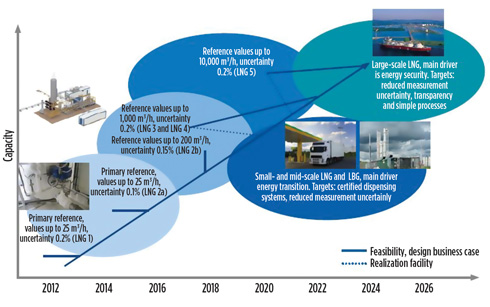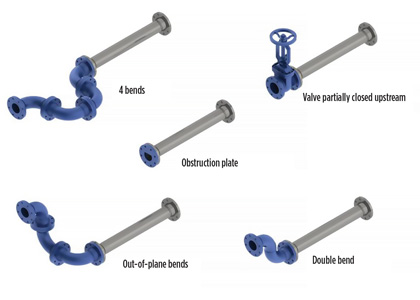LNG metrology—Measurement support for LNG as a transport fuel
The use of LNG as fuel has generated much interest in the global transportation sector due to two main drivers—the environment and cost. First, LNG emits virtually no sulfur oxides (SOX), low nitrogen oxides (NOX) and particulate matter, and significantly less carbon dioxide (CO2) per unit of energy released than do oil-derived liquid fuels. This can reduce the compliance cost imposed by the use of traditional liquid fuels. Second, interest in LNG is also driven by lower prices and by gas marketers’ need to create new markets for now-abundant gas supplies. The lower retail price of natural gas in recent years is a strong driver for LNG penetration in commercial transport.1
Within the EU, the use of LNG forms an integral part of the EU security of energy policy and is one of the pillars of the Union’s clean fuel strategy. The use of LNG in various industry sectors has been underpinned by the European Metrology Program for Innovation and Research (EMPIR). Under this research program, the development of new reference measurement systems for LNG flow and composition will provide manufacturers and developers of LNG sensors with a reliable and accurate platform for testing and validating these sensors, thereby allowing them to advance their measurement technologies beyond the existing state of the art.
European metrology program for innovation and research. EMPIR was developed as an integrated part of Horizon 2020, also called the EU Framework Program for Research and Innovation. Horizon 2020 is the biggest EU research and innovation program ever, with nearly €80 B of funding available over 7 yr (2014–2020).
EMPIR follows the successful European Metrology Research Program (EMRP) executed between 2010 and 2017. The EMPIR calls, launched between 2014 and 2020, have a total allocated budget of €600 MM, with €300 MM from the participating states and up to €300 MM from the European Commission using Article 185 of the European Treaty. The calls will focus on priority areas to address the EU’s priority challenges in health, energy, environment and industry, and to progress fundamental measurement science.2
LNG flow measurement. Since the first EMRP call in 2010, LNG flow measurement and its traceability have been identified by EU national measurement institutes (NMIs) as a challenge and priority area to address.
The LNG 3 project, which is funded under the EMRP, is a 3-yr project started in June 2017 and designed to enable the large-scale rollout of LNG and liquefied biogas (LBG) as transport fuels. The project’s aims will be achieved through the continued development of transparent and traceable metrological infrastructure for flow and composition measurement systems. The project will also develop and validate smart sensors for measurement of methane number (MN) and methane slip (MS) to ensure optimal LNG engine performance.
This project combines the facilities and expertise of nine leading NMIs on cryogenic flow and chemical composition measurements, along with three renowned universities and four industrial partners with significant experience in LNG. The project is also directed by an advisory board consisting of 25 members that are key representatives of the LNG industry (producers, shippers, import terminal operators and energy companies) and instrument manufacturers.
As the project deals with several aspects of LNG metrology, the work is broken down into five main work packages (WPs) to ensure efficient execution of the project. The first WP will continue the development of LNG reference flow measurement traceability and accuracy, which was started in the first LNG project in 2010 so that a target measurement uncertainty within ±0.5% could be achieved using existing LNG metering technologies.
The second WP focuses on the development and validation of a small-scale liquefier using a reference-quality liquefaction technique for natural gas and similar gas mixtures. This reference liquefier will be used to validate LNG and LBG sampling and composition measurement systems. The third WP will develop cost-effective and reliable sensors for measurement of methane numbers MN and MS. The sensors will be validated in the fourth WP in an environment that is typical for existing and future heavy-duty LNG engines.
Finally, the knowledge and experimental data obtained from the first four WPs will feed into the fifth WP—namely, creating impact. The information will be presented to industry through various international committees and in the form of guidelines, new international standards and other publications. More information on the LNG 3 project is available at the project website: https://lngmetrology.info/
Developing flow measurement traceability. The development of measurement traceability for LNG dynamic flow measurement requires the development of primary reference systems capable of calibrating LNG flowmeters with known uncertainty (Fig. 1). For large-scale LNG applications, the development of such a facility is an extremely challenging task.
 |
|
Fig. 1. Developing traceability for LNG flow measurement. |
Since the launch of EMPIR’s first LNG project in 2010, the typical approach adopted for the development of measurement traceability for LNG was to break it down into several manageable stages, starting with small-scale applications (transportation), then mid-scale applications (refueling and bunkering) and, finally, large-scale custody transfer applications (ship loading at export terminals and unloading at import terminals).
In the last two LNG projects, LNG 1 (2010–2013) and LNG 2 (2014–2017), tremendous knowledge and experience were acquired through the successful design and build of the world’s first LNG primary flow standard, capable of handling flowrates up to 25 m3/hr with an uncertainty factor of ±0.1%.
This build was followed by the development of a mid-scale flow standard in LNG 2 that handles LNG flowrates up to 200 m3/hr, using boot-strapping techniques, input from the small-scale primary standard and an independent proving system. The design of this system and a major part of the project were completed in the LNG 2. The build and commissioning of the system will be finalized in the LNG 3 project. This facility will be used to test and verify the performance of ultrasonic and Coriolis flowmeters used in various LNG applications, including refueling. The success of the small-scale and mid-scale systems will play a major role in the realization of the full-scale facility that will be targeted in future development.
In addition to these initiatives, a novel cryogenic flowmetering technology by laser doppler velocimetry (LDV) was developed in the LNG 1 and LNG 2 projects. Results from these two projects have shown that a target measurement uncertainty within ±0.2% is achievable with this technology in cryogenic conditions. The ultimate objective is to use this system as a primary reference standard for LNG flow measurement to enable flowmeter manufacturers to develop and benchmark their meters against this system.
Since the realization of a full-scale LNG calibration facility can be achieved only in the distant future, the project will continue the development of the alternative calibration approach for LNG flowmeters, which is based on transferring calibrations with a fluid, such as water, at ambient conditions to cryogenic conditions by applying appropriate corrections. This economic calibration approach was successfully demonstrated in the LNG 1 project for 2-in. Coriolis flowmeters of different makes.
The verification of the calibration concept will be continued in LNG 3 for both Coriolis and ultrasonic meters supported by cryogenic testing using the small and mid-scale LNG facilities. This calibration scheme is adopted by industry, but requires further independent validation.
Reducing uncertainties in LNG dynamic flow measurements. Initial results from the previous LNG projects have demonstrated that better accuracy can be achieved by direct measurement of the LNG flowrate, rather than by measuring the volume in tanks. However, this testing was carried out in ideal conditions, using small flowmeters up to 2 in.
In the LNG 3 project, flowmeters up to 4 in., from different suppliers, will be systematically assessed for their measurement uncertainties due to several influencing parameters, such as upstream flow disturbances, presence of gas in the flow, meter insulation and meter orientation under both ambient (water) and cryogenic (LNG) flow conditions. The target is to reduce measurement uncertainty to a level comparable to that of conventional hydrocarbon fluids, which is ±0.5%. In addition to the flowmeters, two sensors will be included in LNG testing—an electric capacitance tomography (ECT) device and a newly developed ultrasonic sensor for the measurement of LNG density.
To enable testing of different sizes of flowmeters and comparison of the measurement from each meter against the test facility reference measurement, it was necessary to design two separate metering setups—one to accommodate 2-in. devices and the other to accommodate 4-in. devices. Full testing with water was slated to start in June 2018 and with LNG later in the year (Fig. 2).
 |
|
Fig. 2. Typical pipe installations causing flow disturbance. |
A feasibility study will also be carried out to assess whether a cryogenic piston prover can be used as a primary reference system to verify the measurement uncertainty of cryogenic flowmeters. This will be in addition to the use of the described LDV system as a primary measurement system.
New technique for validation of LNG sampling. In custody transfer applications (ship loading and unloading), the calculation of LNG energy transferred requires measurement of LNG volume in the ship’s tanks, along with the density and gross calorific value (GCV). The latter two are calculated from the average composition of LNG, which is obtained from sampling and subsequent analysis by gas chromatography.
While some challenges with effective measurement are related to the measurement of the LNG volume, the main challenges are with the LNG composition obtained from such sampling. The accuracy of LNG composition obtained from sampling will have a direct influence on the accuracy of calculated density and GCV and, subsequently, on the accuracy of LNG energy transferred. It was shown in the LNG 1 project that, for an average LNG cargo, an error of ±1% in energy transferred may result in €0.5 MM in misallocation during custody transfer. The significant value of LNG ship load, therefore, justifies the most accurate and reliable LNG analysis system.
While many well-established LNG sampling and analysis systems have been adopted by the LNG industry, no reference systems exist to accurately benchmark their performance. The need for such a reference system was identified in the LNG 1 project, and this need will be addressed in the LNG 3 project through the development and validation of new reference liquefaction techniques for natural gas and similar gas mixtures.
This reference liquefier will be used to validate LNG and LBG sampling and composition measurement systems. The approach relies on knowing the compositions of LNG mixtures and then introducing the LNG to the sampling and vaporization system, which is required to vaporize the sample in a controlled environment without loss or change in composition before it enters the gas analyzer (gas chromatograph). The composition reported by the analyzer will be checked against the known composition of the mixture. Similarly, the reference liquefier can be used to validate the direct composition measurement, using the Raman spectroscopy technique under development for LNG.
New cost-effective inline measurement sensors. The composition of the LNG, energy content and other physical properties varies from source to source. Furthermore, the LNG composition in LNG carriers and storage tanks typically changes over time through a process known as “aging,” which means that the LNG composition becomes richer in heavier components.
For fiscal measurements, the physical and chemical properties of LNG are defined through sophisticated LNG sampling and analysis procedures. These processes involve several careful steps including sample collection, conditioning, vaporizing, analyzing, reporting LNG composition and, finally, calculation of LNG properties and energy content. However, for monitoring and control purposes, it may not be practical or cost-effective to use such equipment. Development of cost-effective sensors that can be easily installed in-line and provide acceptable measurement accuracy are required.
The development of in-line miniature gas composition sensors has already started in the LNG 2 project, and their potential use for LNG engine management and performance monitoring has been successfully demonstrated in initial trials. To operate an engine in the most efficient way, it should be run as close as possible to its knocking point—i.e., the point during the engine combustion where part of the fuel spontaneously ignites ahead of the flame front and burns in an uncontrolled manner. The methane number (MN), together with the engine type and the operational conditions, determine the knocking point. To run the engine at its most efficient setting, the MN must be determined using accurate sensors that will be developed, tested and validated in the LNG 3 project.
Depending on the combustion process, part of the methane (CH4) may not burn in the engine and, therefore, can be released to the atmosphere (as MS). For economic and environmental reasons, the engine performance needs to be carefully monitored and managed through the use of an MS sensor to facilitate increased combustion efficiency and reduced methane emissions.
Dissemination of information. The new results from this project will be disseminated to international organizations in the form of guidelines and standards related to LNG metrology. The aim is to create a significant impact that facilitates international acceptance of the project results. The international working groups from the International Group of Liquefied Natural Gas Importers (GIIGNL), the International Organization for Standardization (ISO), the European Committee for Standardization (CEN), and the International Organization of Legal Metrology (OIML) are collaborating to achieve this goal.
In addition, the project impact is maximized by other activities, such as organizing workshops and conferences, presenting the project’s results at conferences and in scientific and key user journals. Two workshops are planned: the first at TUV SUD NEL (UK) in October 2018, and the second at Ruhr-University Bochum (Germany) in 2020. The workshops held the previous LNG 1 and LNG 2 projects presented an excellent platform for sharing information and experience between the project partners and the LNG industry. Detailed information on these events will be published on the project website: https://lngmetrology.info/ GP
LITERATURE CITED
***
 |
Asaad Kenbar is a Principal Consultant at TUV SUD NEL, a provider of technical consultancy, research, testing, flow measurement and program management services to the energy and manufacturing industries, as well as to government. TUV SUD NEL, part of the TÜV SÜD Group, is the custodian of the UK’s National Flow Measurement Standards.




Comments